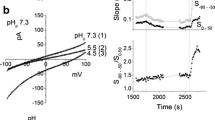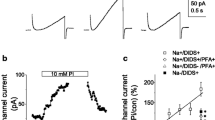Abstract.
Patch clamp experiments were performed on two human osteosarcoma cell lines (MG-63 and SaOS-2 cells) that show an osteoblasticlike phenotype to identify and characterize the specific K channels present in these cells. In case of MG-63 cells, in the cell-attached patch configuration (CAP) no channel activity was observed in 2 mm Ca Ringer (control condition) at resting potential. In contrast, a maxi-K channel was observed in previously silent CAP upon addition of 50 nm parathyroid hormone (PTH), 5 nm prostaglandin E2 (PGE2) or 0.1 mm dibutyryl cAMP + 1 μm forskolin to the bath solution. However, maxi-K channels were present in excised patches from both stimulated and nonstimulated cells in 50% of total patches tested. A similar K channel was also observed in SaOS-2 cells. Characterization of this maxi-K channel showed that in symmetrical solutions (140 mm K) the channel has a conductance of 246 ± 4.5 pS (n = 7 patches) and, when Na was added to the bath solution, the permeability ratio (PK/PNa) was 10 and 11 for MG-63 and SaOS-2 cells respectively. In excised patches from MG-63 cells, the channel open probability (P o ) is both voltage- (channel opening with depolarization) and Ca-dependent; the presence of Ca shifts the P o vs. voltage curve toward negative membrane potential. Direct modulation of this maxi-K channel via protein kinase A (PKA) is very unlikely since in excised patches the activity of this channel is not sensitive to the addition of 1 mm ATP + 20 U/ml catalytic subunit of PKA. We next evaluated the possibility that PGE2 or PTH stimulated the channel through a rise in intracellular calcium. First, calcium uptake (45Ca++) by MG-63 cells was stimulated in the presence of PTH and PGE2, an effect inhibited by Nitrendipine (10 μm). Second, whereas PGE2 stimulated the calcium-activated maxi-K channel in 2 mm Ca Ringer in 60% of patches studied, in Ca-free Ringer bath solution, PGE2 did not open any channels (n = 10 patches) nor did cAMP + forskolin (n = 3 patches), although K channels were present under the patch upon excision. In addition, in the presence of 2 mm Ca Ringer and 10 μm Nitrendipine in CAP configuration, PGE2 (n = 5 patches) and cAMP + forskolin (n = 2 patches) failed to open K channels present under the patch. As channel activation by phosphorylation with the catalytic subunit of PKA was not observed, and Nitrendipine addition to the bath or the absence of calcium prevented the opening of this channel, it is concluded that activation of this channel by PTH, PGE2 or dibutyryl cAMP + forskolin is due to an increase in intracellular calcium concentration via Ca influx.
Similar content being viewed by others
Author information
Authors and Affiliations
Additional information
Received: 17 September 1995/Revised: 7 December 1995
Rights and permissions
About this article
Cite this article
Moreau, R., Hurst, A., Lapointe, JY. et al. Activation of Maxi-K Channels by Parathyroid Hormone and Prostaglandin E2 in Human Osteoblast Bone Cells. J. Membrane Biol. 150, 175–184 (1996). https://doi.org/10.1007/s002329900042
Issue Date:
DOI: https://doi.org/10.1007/s002329900042




